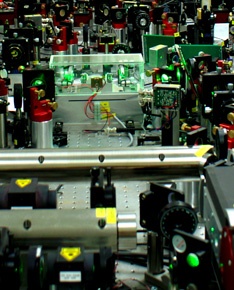Jun 25 2009
Faster computers, more secure information transfer, smarter sensors - all technologies that could benefit from a new, simpler way of manipulating light to convey much more information using fewer light beams and resources.
 The experiment array from the ARC Centre of Excellence for Quantum-Atom Optics at ANU.
The experiment array from the ARC Centre of Excellence for Quantum-Atom Optics at ANU.
A research team based at The Australian National University has developed a breakthrough approach to generate quantum entanglement, where information is coded in the physical relationship between two objects. Their findings are published in the journal Nature Photonics this week.
Research leader Dr Jiri Janousek from the ARC Centre of Excellence for Quantum-Atom Optics at ANU said that the discovery is based on existing optical technology, but uses it in such a way that much fewer components and light beams are required.
“Light beams produced from lasers can be used to convey information via a process known as quantum entanglement,” Dr Janousek said. “Basically this means that at the miniscule scale of the quantum world, information about one object – a stream of photons, for example – can convey information about another object to which it is linked. We can use quantum entanglement, or optical entanglement, to convey information.”
“Until now, the amount of information that could be conveyed using optical entanglement was limited by levels of complexity. The ability to scale up information transfer is hampered by the fact that you need to increase the number of nonclassical light sources, splitters and receivers each time you want to add another channel of information. This means that multi-channelling has been consigned to the too-hard basket – too many parts for too little effect.”
Dr Janousek said that the group’s discovery about mode manipulation in light meant that only one light source and one receiver is required to generate optical entanglement, meaning that this approach could be much more simply scaled up to convey many times more information channels.
“There are only ten labs in the world that would be able to do this kind of research, and we were the first to find a solution to this particular problem,” Dr Janousek said. “This finding is one more piece in the puzzle towards the future realization of quantum computers, which would be many times faster and more powerful than existing computers. But in the medium timeframe this discovery could assist in the development of quantum technologies – things like quantum communication and information processing.”
The research team included scientists from ANU, the Laboratoire Kastler Brossel in Paris and the Australian Defence Force Academy. The project was funded by the Australian Research Council, with support from ANU, CNRS the Ecole Normale Superieur, and the European Commission’s Seventh Framework Programme for Research.